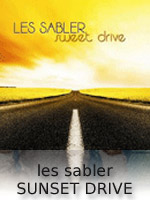![]()
 |

Release Date:
September 25, 2007
Reviewed by:
Anne Aufderheide
I like to discover new artists and I bet you do too. Have you heard of guitarist Les Sabler? Well, I don’t know where I’ve been, but I had not. What first caught my attention is his new CD Sweet Drive has been nominated for two Canadian Smooth Jazz Awards. So I gave it a listen and am glad I did. If you’re a fan of jazz guitar, you’ll want to check it out too. Sweet Drive is nominated for “Album of the Year” honors at the 2008 Canadian Smooth Jazz Awards. Sabler has earned a second nomination for “Guitarist of the Year.” In addition, Smooth jazz radio program Café Jazz named Sabler the #1 most played Canadian artist in 2007. Sweet Drive was the #1 most played album by a Canadian artist, and “Club Street” was the #2 most played single by a Canadian artist. The second thing that caught my attention was the stellar lineup of artists who contributed to Sweet Drive. Ace-bassist Brian Bromberg produced and played on the record. Sabler surrounded himself with some of the best contemporary jazz musicians of the day, including Alex Acuna, Vinnie Colaiuta, Jeff Lorber, Eric Marienthal, Ricky Peterson, Mark Hollingsworth, and Gary Meek. Most of the brass sections were arranged by Jerry Hey and performed by the Seawind Horns, who are, in fact, Jerry Hey, Gary Grant, Bill Reichenbach, and Dan Higgins. Rahsaan Patterson, Toni Scruggs, and Richard Jackson spice up tracks with some sultry and soulful vocals. How can one go wrong with all this righteous talent?! Then I come to find out Sabler has been headlining and opening concerts for artists such as Jeff Lorber, Spyro Gyra, Richard Elliot, Michael Lington, Diane Schurr, and Fattburger. Now, that’s excellent company to keep. Sabler studied the artists on the CTI Records label, such as George Benson, Larry Carlton, Lee Ritenour, and Wes Montgomery. Sabler derived inspiration from pioneering contemporary jazz records from the 1970s; those are the albums that influenced him to become a musician. The music of that era blended a variety of styles while balancing musical prowess with commercial accessibility. He was also inspired by blues artists like John Lee Hooker and took a tangent for indepth study of the blues. A Montreal native, Sabler’s fourth album is a wide-ranging, soulful body of contemporary jazz, R&B, and adult pop, released by The Music Force record label. It has all the right elements for success - masterful performances by Sabler and a star-studded supporting cast, well-crafted songs, and superb production values. The first time I heard the album, it sounded familiar yet fresh and inventive. Of course, there are cover tunes, but that wasn’t what was so attractively familiar. This music has chops and class. From track to track, Sabler changes up style, texture, tempo, and mood revealing a wide range of guitar voices - from edgy electric fusion to cool jazz and warm nylon-string acoustic guitar. Listeners are treated to an enticing and adept body of music. “This is an important record for me and I put everything into it. There were no compromises,” said Sabler. “I put a lot of thought into the song selection and trusted Brian Bromberg to guide my performances. With the gifted players he assembled, it inspired me to bring my ‘A’ game.” Sweet Drive consists of
eight originals and four covers. “I wrote most
of the songs on my first three albums, but for this one, I went through
my record collection looking for great songs that hadn’t been
recorded before with smooth jazz arrangements,” explained
Sabler. One of the songs he found on an old Quincy Jones album
that Stevie Wonder penned, “You’ve Got It Bad Girl,” which
opens the CD. Sabler plays electric guitar accompanied by Eric
Marienthal’s velvety sax, Gary Meek’s spirited flute,
Brian Bromberg’s dark acoustic bass, and Jeff Lorber’s
inspired keys. The silky tones of the Seawind Horns meld with the
honeyed vocals from Toni Scruggs and Rahsaan Patterson, creating
a gorgeous backdrop for Sabler’s guitar. |